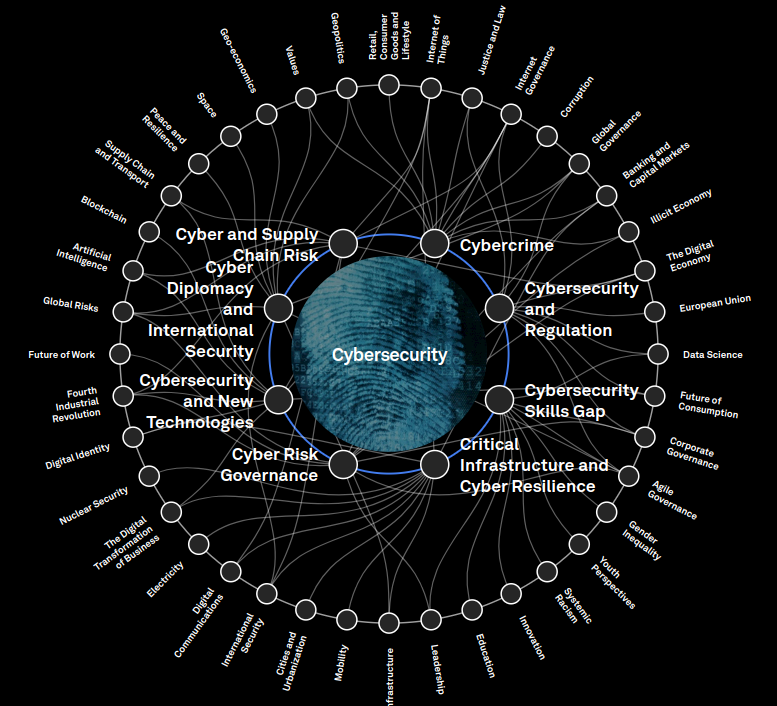What is a Real Future?
There came a point in my life, where I had spent an inordinate amount of time pursuing different career options that were presented to me. Again and again, chattering class and sales types would give me a panglossian view of the field, and forget to mention any of the negatives, nor spend even a few minutes assessing if the person they were presenting to was even a good fit in the first place.
Overtime, I surmised that most futures that were presented to me were fake. One must construct their own, as no cookie cutter solution can possibly work for ones unique abilities, passions and limitations.
There are a great number of fantasies and frauds that are presented to people on-line. This is because of the way attention and rewards work with feed algorithms on the internet. Things that are viral and emotionally charged spread. And for the salesman/influencer, who’s primary market consists of comfortable, rationally-economic men, he knows that it is better to cast a wide net with untruths, then to be completely honest. This insures that a higher percentage of people will enter his little funnel. Telling hard truths to regular people is a recipe for repulsion anyways [2].
To begin, I quickly contrast what I believe is a “real” v.s a “fake” future. We start with signs, and then derive a general definition in each case.
Real Futures:
First let’s start with the signs of a real future:
- It is on the cusp of new developments or future needs. It is not established and stale.
- It intersects with other related new fields. Individual specialisation and niches can be carved out, by the right set of prepared people.
- Authentic Gate-Keeping:
- The barriers to entry are hard/strict. Real skill, talent and knowledge is needed to create and generate economic wealth.
- Those who are “in” are highly selective with their time. Two word evasive answers, or auto topic switching will occur if you are a low-potential outsider trying to find out more.
- You observe that the top few percent of humanity are actively pouring their time into carving their niche in this zone, or appear on the other-side of the barrier.
- It is somewhat resistant to tech acceleration (at least, for a half-decade).
A real future is one that allow someone to create real economic wealth in new or novel ways and carve a channel for themselves. This yields upwards socioeconomic mobility and personal profit, for a set amount of time.
Compared to Fake-Futures:
The Signs:
- Anything where the primary focus is consultancy, middle-manning, thought-leading, message passing, rent-seeking, predatory no-value-added sales, and media influencer roles.
- Anything well established, that is vulnerable to automation. If industries can’t increase their profits with growth, then they will eventually do it with human downsizing.
- No obvious wealth is generated from the proposed “future” (for most of the participants involved).
- Lots of hype, pretense and powerful presentations, but no actual substance. Vaporware. Scams and “Easy Money”.
- Obvious low barriers to entry, and over-saturation. If anyone can do it, you should not.
- Inauthentic Gate-keeping: The future presented is made out to be a golden ticket for only a select set of individuals. After this sales spiel, anyone can just pay money and sign up.
- Manufactured certifications and niche markets created by corporations, with a by-product of increasing their own market-share and creating a credentialed serf class (such as Cisco/Amazon Certifications).
A fake future is one that has already been played out, is someone else’s get-rich-quick scheme or comfy in-feasible fantasy, or is a contrived market niche created by some authoritative entity to largely benefit itself.
Notice the narrowness of what I define a real future to be, and the broadness of a fake future. Fake futures are everywhere – from unconditionally positive TED talks, to shitcoin launches, to four-hour workweek passive income lifestyles. To focus on a real future, we have a lot of screening and discrimination to do.
Everyone wants to be a Data Scientist: Watching a Frame Drift Away:
When I was in University, Data Science and Machine Learning were starting to really take off. I was in the last Machine Learning class that Geoffrey Hinton taught (CSC321)[3].
After I graduated, I didn’t immediately try to pursue Data Science, but after a few years, I decided to give it a try. Unfortunately, by this point it was already becoming over-saturated. Basically, the opportunities that I saw earlier seemed to be drying up.
I knew people that were still getting Data Science jobs (PhD’s in Applied Mathematics + Physics, most reliably). It wasn’t impossible. But the chances for a non-PhD without a will of tempered iron were becoming increasingly slim. As I kept doing online learning and applying for jobs, there were two harbingers that appeared, that opened my eyes to what was going on.
(1) Talent.works: The Science of the Job Search
Perhaps the first omen, after struggling for a year came in the form of a Data Science start-up selling hiring analytics and automation tools to job-seekers (which existed from about 2016-2020[4]). As a natural web 2.0 side-effect of the business, they collected large pools of data from their participants. So the Data Scientists in the company did summary statistics, and tested various job seeker hypothesis, to give job seekers more insights. A few of the insights and visualisations they derived can be seen below:
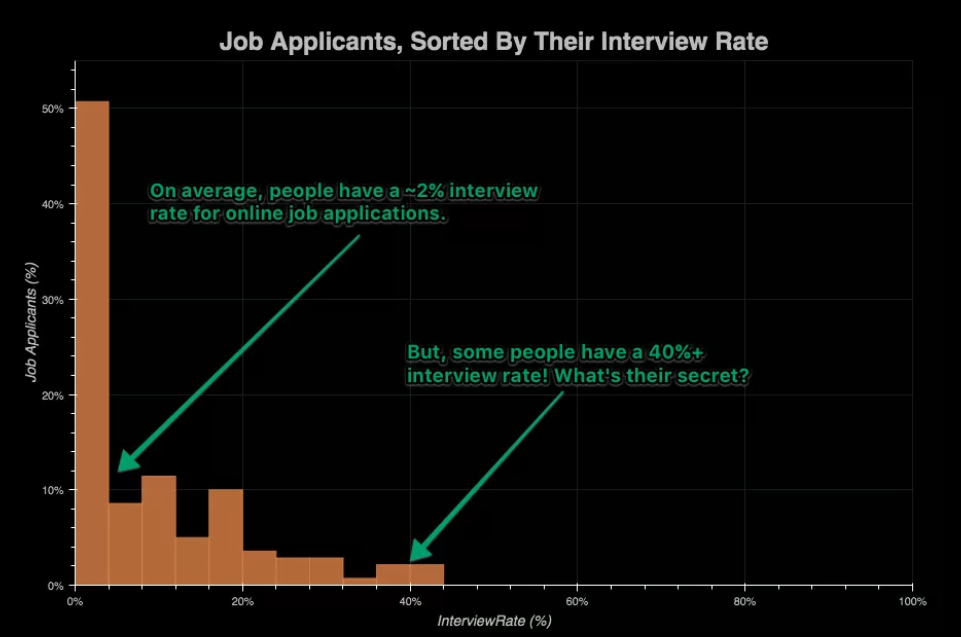
Chart 1: Histogram of job applicants and their interview rate. Even getting a job back in 2018 was hard.
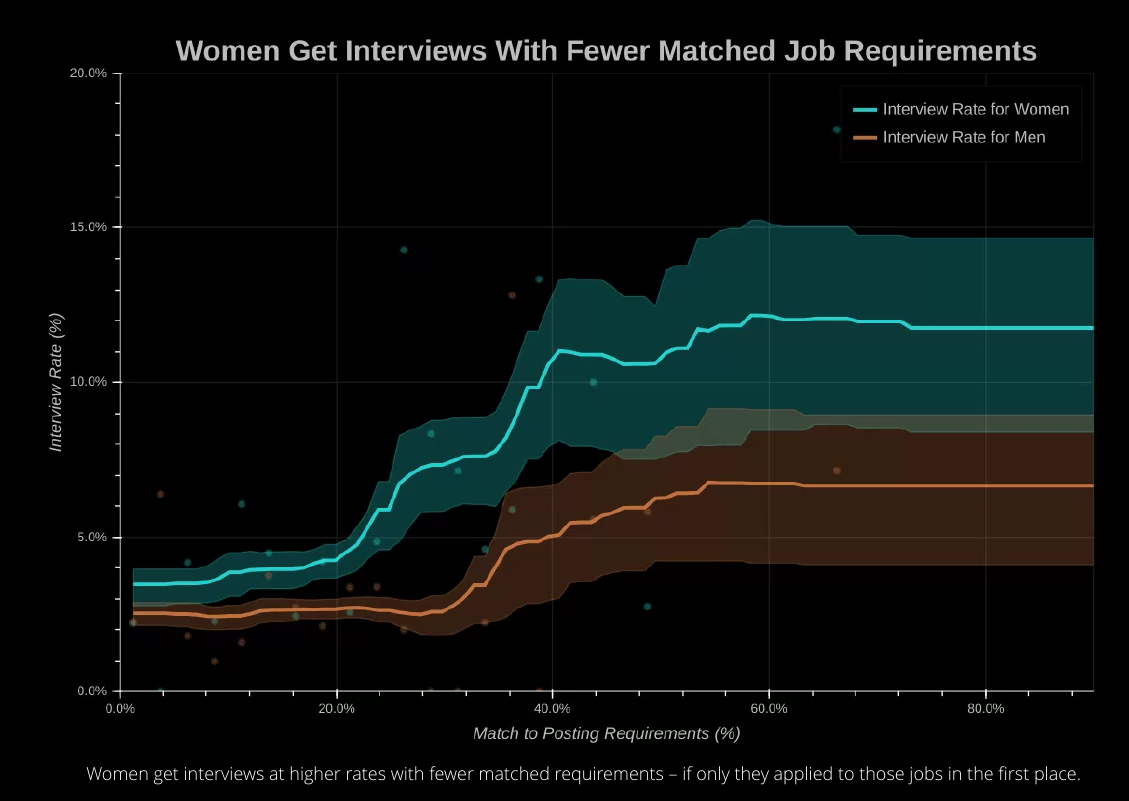
Chart 2: Percentage of requirements v.s interview rate between men and women. Notice the obvious boost in the curve for women.
Some sample insights:
- Peak employment age is 25-30, drop-offs in both directions outside of this range.
- Women, especially in male dominated roles, more easily get
interviews
- Men need to be (safely) 1.5x-2x better than women, to have a decent shot at an interview..
- Tough out a bad job for 18 months, to minimize screener penalties.
- …etc.
Of course this was true before the global pandemic. With AI generated slop everywhere, and the adversarial games between HR and prospective applicants locked in an evolutionary cycle of increasing complexity, things are overall worse for applicants, now days.
So after reading all those job post analytics, a feeling of futility started to come over me. The job search economy did not have my demographic at heart, and application processes necessarily had to be automated and screened (due to the sheer number of applicants), which makes a job seeker’s life worse. To me, it appeared that if one was not in the top few percent, you have a hard grind ahead of you, and will be made to compromise if money is an issue.
All of this started to diminish what natural drive I had left. What short bursts of willpower I had in reserve were getting smaller and smaller, as I kept working with no results. I would frequently get discouraged, living in a situation where I took few good jobs peppered with dead-end jobs – none of them relevant to Data Science.
I remember the time when I gave up, looking back. On my Data Science grind, I went to many “free” training sessions. I went to endless Meetups, where there were all sorts of distractions along the way. People trying to get me to do Python or Java jobs. People trying to get me to sign up for Data Science “Bootcamps”. People trying to do resume coaching on thin slivers of relevant applicant experience.
But really, a lot of these people were chattering, consultant and managerial class people trying to sell us all shovels for a Gold Rush that had long matured [5].
I never got anywhere with this. I was just spinning my wheels and dressing up my mediocre work. Then I read a tweet that shattered my world:
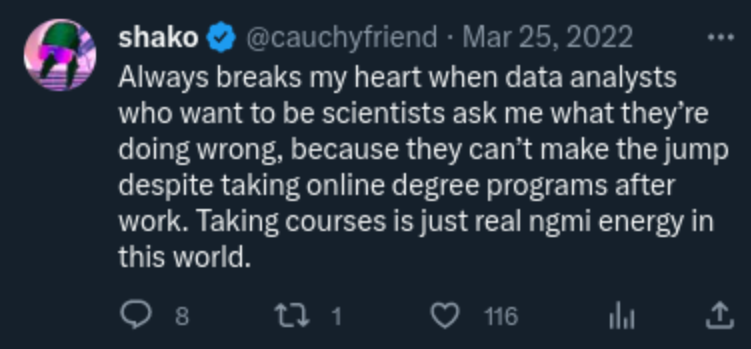
Breaking the Frame:
You see, in that moment I realised I was trapped. Framing my mind was a kind of toxic residue – that of the credentialed economy that was gate-kept by universities and authoritative experts. This is what I had implicitly internalised from University, and from society. I needed some proof for others, who held the keys to success. All the rock-star developers, and rigorous STEM professors[6]. So I kept grinding away at online learning, and reading, and listening to other peoples “stories” about how they got to where they were[7].
Lots of people (with a penchant for words) would write articles and give critiques of the environment, trying to “help” us. In reality, this just magnified the echo chamber and noise. So many of us were lost and confused in a maze crammed with humans slowly grinding away their talent, life and energy, hoping that it would “somehow work out…”. For many years, people just went to University, spend 6 months looking for a job and it usually worked out. But for many, that hasn’t worked out for the last 15 years or so[8].
I completely missed what I was supposed to do – getting lost in the noisy job search economy, and not being a complete enough person to persevere. I was totally preoccupied on feeling envious of the performances of others (which may or may not have been true), and running on the hamster wheel of “keeping up” and “staying relevant”, to do what I was supposed to do.
Looking back, most of it was worthless, and a waste of life [9].
How to get a Data Science Job: Just Make One
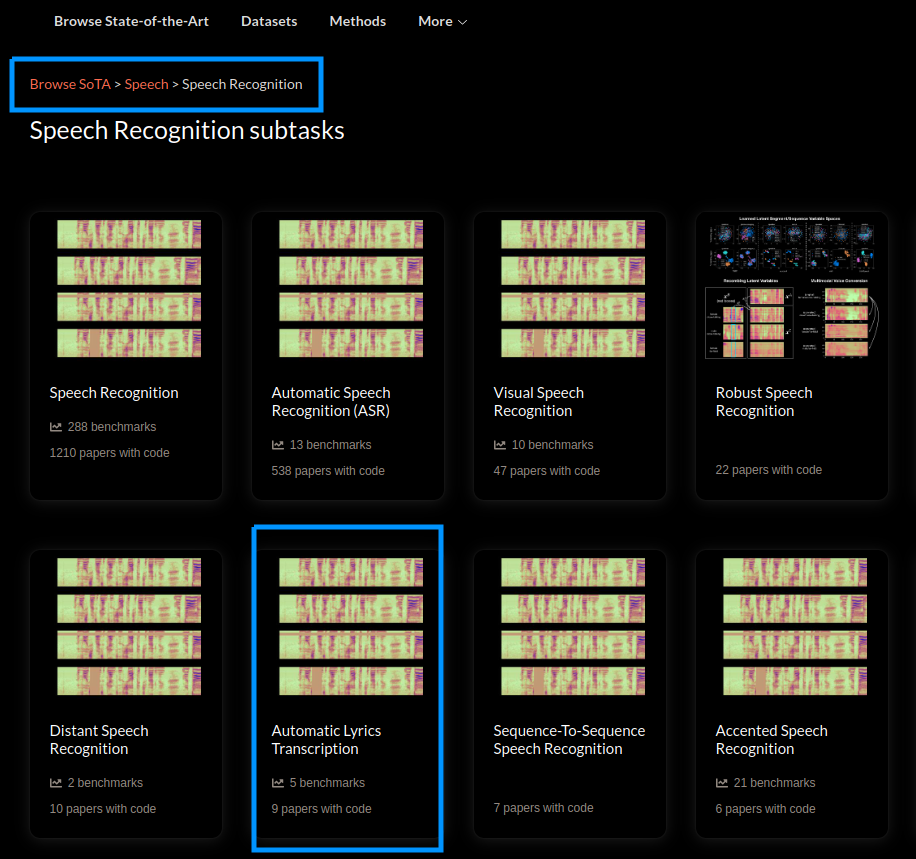
Go on Papers With Code. Choose something you find interesting, drilling down by topics and sub-topics in the “State of the Art” section. Choose a problem you like. Become an expert in it, and add to its solution. Read the papers, and build something. Ideally slap a front end and host a website, with your project on the back-end[10].
The End.
That’s what you have to do. Not resume massaging. Not listening to Joe Data Scientist on a podcast, talking about his “life journey”, not reading another KD Nuggets list article.
Nope.
Just build something, or improve something, and make it presentable online for people.
It doesn’t matter if you don’t have a super-computing cluster, getting within Y% with a fraction of the resources is impressive in itself. Look at papers, telling you what further research could be done. Try it out. Take some risks and expore.
That’s what real problem solving and innovation is. Everything else is just neurotic, dysfunctional, or procrastination as a way of avoiding engagement with the real world, which is a source of fear for many.
More succinctly: you must have the drive and willpower to solve a problem that the economy deems to have value. This is the goal you focus on.
To really hammer the point home, consider the two following scenarios, which compare two different mindsets and approaches:
Person #1 (P1): Is interested in Automatic Lyrics Transcription for songs. He has read the papers, and has set up a data pipeline with a data set of 1000 songs, and all the ML libraries + pieces of software he needs to train the model. He has bought a blade server for $500, because this will pay itself back after 6 months, compared to the high computing fees he pays with DO, or AWS.
He grinds away, trying different things. He uses a chat robot for guidance, and browses ancillary papers (on Sci Hub). He identifies key people in the field (employed at start-ups, or other professionals), and attempts to engage with them. He even dives into the haunted old world of Stack Exchange, to get help at times.
With decent results from his grind, he starts thinking about how he can create a web interface for people to use. He goes to the usual watering holes (Reddit, Twitter, etc), to shill his project.
P1 knows he can’t beat Spotify, Shazam or the research groups that wrote the papers, as these have large teams of talented people and access to super-computing clusters. But he can implement niche features they have not got to yet, and attempt to monetise them, or at least show them off.
He has demonstrated that he can take an idea, and through his own drive and force of will, implement a solution. If he can’t sell his idea, he can at least try to get a high paying specialist job. And if that fails, he has the veteran experience to go from idea to usable demo, all over again.
Person #2 (P2): Doesn’t really know what they want to do, but they know they want to get into this Data Science thing. They don’t really want to be a Python or Java developer. They can do those jobs…but it sounds quite tedious.
So they start doing Coursera and Udemy courses. They go on blogs and Twitter, to learn more about the field from those at the top, following their every word. They start applying for jobs. The rejection rates are huge. They balance trying to apply for many jobs, do online learning, and trying to build something.
They are so exposed to different opinions from “experts”, that the goal posts shift continually. P2 has to keep relevant on LinkedIn, and put hours of work for job applications, just to get one interview out of a hundred. After a year, they have bits and pieces of portfolio work, and a lot of job applications.
In the end they have a very shiny resume, which dresses up a lack of experience and achievement. Number of Problems solved: Zero. Expertise acquired: not much, as they are very broad and shaky from trying too many different things.
The point is that P1 didn’t much care about what Joe Data Scientist was saying, or what the CEO of Microsoft was posting on LinkedIn. He didn’t waste time doing online tests, or dressing up his resume. He realises at a certain point, that if he wants to sell his idea or make a startup, he will have to work on his presentation skills. But this is after he has field-tested his idea, and knows that it is feasible.
He doesn’t unnecessarily waste time on the performances or pretences projected by others. He solves the problem, and the presentation and polish for whatever his exit is (startup, generate passive income online, get a niche tech job), is just another sub-problem in his goal of delivering a recognisable solution to a problem the economy needs solved.
P2 is completely lost, in a sea of noise and a plague of fantasies sold by others. He accomplishes nothing. With his drive and goal in the distance, P1 focuses his energy in a productive way, and is able to create something [11].
Maintaining a Feeling of Safety - with Little Financial Security:
Earlier on in my previous sections, I had used words such as “drive” and “willpower” throughout. For the former, I specifically mean one’s internal motivation to expend energy to pursue goals and aspirations on a long term scale. Drive is a feeling where one is motivated to work towards a goal – with some level of confidence and tenacity. It is not artificial, and should come to a healthy, stable person naturally. For the latter, willpower means exerting conscious mental effort to overcome the difficult, or focus on the most critically important task (either out of urgency, or because of large obstacles). Together drive, with intense moments of willpower dotted throughout, are supposed to encapsulate the experiences that (P1) exhibited above.
Of course, these things are not easy to attain on a consistent basis. Most people need a form of safety and security, as well as other needs met in their life. When one is secure, they know they will not be abused, or thrown out in the street tomorrow. When one has a safe place to stay and consistency in their life, they can know whatever they build wont be reduced to rubble the next day.
There are all sorts of other forms of security one needs. Like personal and interpersonal security. The security and feeling of actually knowing oneself. Of having strong boundaries, for oneself and that can be imposed on others that transgress or perform nefarious actions. Also freedom from the tyranny from other parasitic, overbearing and chaotic entities (from cluster B’s, to institutions and unstable societies and everything in between).
There are all sorts of other forms of security one needs. Like personal and interpersonal security. The security and feeling of actually knowing yourself. Of having strong boundaries, for yourself and that can be imposed on others that transgress or perform nefarious actions. Also freedom from the tyranny from other parasitic, overbearing and chaotic entities (…from cluster B’s, to institutions and unstable societies and everything in between).
One can have all of that, but still suffer mentally (the usual melange of depression, anxiety and trauma). There are a huge number of safety and security requirements most people need before they can project themselves to better places. Because if we feel it’s all going to disappear tomorrow, how can we project our power and tenacity in a focused manner, day after day?
There are a great number of resources posted, describing how one can solve the above safety issues. Once all that was done (for me), there was one final issue I struggled with.
The last conundrum for me was solving the above problems, but being trapped because of (i) having no pattern of personal success, (ii) being used to continual poverty and (iii) having a historical pattern of failure – where things are not achieved or abandoned, because each of the safety issues is exposed one by one and has to be resolved before one can progress.
If I am paycheck-to-paycheck, how can I possibly feel safe when anything can break at anytime? I when I am just a root canal or broken laptop away from having $0 in my bank account? How does one find the drive to go towards something they really want to build? How does one find what they even want to build and go out and take risks, when Physiological and Safety needs can never be met?
I want to join a scene and make money, but it is accelerating quickly and I am fairly low on time and resources. I can take the risk, but there is no guarantee it will work out. In pursuing such things, my life may become so precarious that is pushes me over the edge and my living situation becomes even worse.
And the world does not care either way.
One goes for it, but it doesn’t work out because someone beats them to it, or things change to quickly, or they’re not quite spec’ed to be the person who really would excel in this cutting edge little world they are trying to make it in.
These are hard truths one needs to face.
If this happens, I can’t just sit in a hole depressed for a month – my savings will dwindle. One needs to take the Hollywood montage of striving and just being handed the prize, and get that out of your mind. The world is more complicated than that.
With all those fears in mind, here is how I solved it:
(1) Build One Year of Savings:
At the minimum, so that you can weather incoming storms. Frugality must be strictly maintained, cutting all unnecessary expenditures. Grit and perseverance must be cultivated. And simplified living must be practised. The most amount of time and money gleaned from such endeavours must be cobbled together into longer stretches of time, so that one may focus and perform deep work. A proper survey of the prospective environment in which to innovate serious solutions must be made beforehand. If Joe Nobody[12] is telling you to get into predictive AI for macroeconomic models because some podcast guy persuaded him, immediately assume that ship never existed, or sailed years ago and already made it to the new world. Not even worth your time.
Most people deal with the unfairness of this all, by covering their pain with vices and comfort. This temporarily gives them an escape, and makes them feel safe. But these have drawbacks and cause you to dull your drive, among other things.
So how does one avoid the comfort and vice trap? How can one feel safe, even if it will be a long time before one has money (in which large amounts are the necessary root of personal and material safety)?
Answer: It’s done with a mental trick – one that the top few percent of humanity intuitively believe and understand:
(2) The belief in One-Self, and in Near Limitless Opportunities:
I inferred that large portions of the top few percent, are much more connected to the opportunities available in the world, compared to the the average person. They are in touch with the divine/sublime, and connected to the creative spirit[13]. They don’t worry too much about money (even when they were not wealthy), because they instinctively know there are opportunities available in many places, and they will probably be fine.
Once more, lets contrast two hypothetical people with differing mindsets, to illustrate this:
Assume both Precariats [14] below have the same living position: Just $2000 in a checking account (all the money to their name), they work full-time at a low-wage job, and have perhaps $200 left over to save at the end of the month. They already live frugally and don’t spend degenerately. A simple broken laptop or dental emergency can wipe them out at any time, and they live with this risk in the back of their mind.
Precariat #1 (Pc1): Doesn’t waste time with what is being chattered about online, or the online news. He knows he has no power, and that a world based on credentialism and social hierarchy doesn’t care about him. He knows that there are tonnes of opportunities online, but things are moving very fast. By the time he finishes something, the world might not care anymore (that ship has already docked…or sunk). This is his major stressor in life. But note that not all stressors are bad. Just like the average man who almost convinces a super model to go on a date with him, Pc1 knows he is in the right space, and is doing the right thing. These losses are not painful, they are signs that he is going the right way. He keeps drilling.
He has identified a few fields he would be best in, and he reads up on the cutting edge, cultivating high quality sources. He attempts projects of various scale (usually on the smaller side…), based on what he perceives is the best thing at the time. His frustrations lie in the fact that a new technology can come out, making something he is working on obsolete in a matter of months. He has no choice but to pivot or start something new.
Pc1 is not physically or financially safe. His safety comes from the fact that he has cultivated the opportunity sources to be one of the early entrants in various sub-fields and niches, and he selects lower time/resource projects regularly. He keeps striving. He knows he needs unlimited time and lots of money in the bank to more easily make it. But every project he works on has a few percent chance of catching on, or getting a start-up/higher paid gig, so he keeps plodding on. And if everything goes south at once, leaving him in dire straights, he can at least attempt to get a higher skill job, and rebuild his savings runway.
Precariat #2 (Pc2): Is constantly worried about money. He is torn – between not doing the work to understand who he is or what he wants to do - and the immediate fear of losing what little savings he has, which forces him to compromise himself. He is compromised in various ways, reaching out desperately in all directions to try and assuage himself. And of course, he will find chattering and thought-leading class members, trying to sell shovels and alpha (for engagement) at various points of a social media feed algorithm, as he tries to distract himself from his chronic stress.
The noise will be overwhelming, and he’ll be pulled in all directions. He will mistakenly worry about macroeconomic indicators, or try to gamble on tech stocks based on tech bros posting comments on a feed, which will eat up his precious time. The world will keep marching on, as he keeps feeling like he is left behind. The stress and cope will become addictive, and forever he will stay – reading the questionably true accounts of those who shill themselves on social media platforms, hoping to gain an edge he can’t take advantage of.
In the end, he is just spinning his wheels in frustration, which erodes his creative energy and incomplete drive – the very tools he needed to escape his predicament in the first place.
The point I am trying to get across is, you can’t easily fool yourself into feeling materially and financially safe when you are not. You can’t ignore being low on cash or living precariously. I found was that having a runway of savings, and possessing that feeling that one has lots of opportunities available, was sufficient to fix my final safety hole that was plaguing me.
If you take anything away from all this, please ask yourself the following question: If you were on the sinking Titanic, but there were infinite lifeboats… would you really fear death?
The Idea of Acceleration Frames:
As a final piece to our future-finding strategy, we need a conceptual model to deal with the day-to-day physical picture of what we are trying to achieve.
The only reliable way to make money and create a legacy + real future, is to solve upcoming problems that humanity faces, or at least join the train of problem solvers early, to be well positioned to sell a solution and make a profit.
The expansion of key high-tech industries, and the new economic spaces they will open up (such as outer space, new computing platforms, healthcare and longevity, etc), will necessarily intersect, and create niche problems that we – the creative and driven class – must solve.
To solve any hard problem, we need a combination of attributes. Grit, perseverance, drive and creativity, among other things. For without drive, there is no hope in finding a solution. Someone without the drive to push toward the solution will necessarily be derailed, distracted, or will fritter away their time assuaging fears, or non-problems that feel like progress.
Chattering, managerial, and empathetic have over-focused on “network being our net worth”, and emotional intelligence. All of these things are secondary goals, in service to actually solving the problem in a profitable and streamlined way.
For any particular problem or industry, we must be familiar with the state of the art, and where the industry is before we can attempt to solve a problem. As we are learning intensely, and trying to get to the cutting edge of the field as a whole, the bounding edge we seek is moving as we are moving. In fact, due to technological advances, it is actually accelerating.
We need to change the way we think about employment and problems. For the top few percent, they seek to own a particular problem, and solve it. Either via adept expertise (say – contract programming), or by running their own company. They don’t think about getting a job for someone else – although this can be a valid exit if things get too heated, and they need a payday to cement some kind of life and legacy.
Note that due to increasing automation, the nature of work must necessarily evolve this way (ignoring government edict’s that necessitate minimum human quotas). Work will be a joy that only the top few percent get to experience. Those who create and build there own dreams will be a special class of people. Robots and AIs will eventually do many of our tedious tasks. Why have 10 programmers, when you can have 1 manager, and two 10x programmers that have a number of AI bots that assist them?
Programmers in the 71st percentile need not apply.
The rest of humanity - those that can’t actualize and become complete, functioning human beings - will be relegated to consumerism and past-times, having their time filled in by whatever globalist/bureaucratic vision is imposed on them at the time. Slowly and painfully, a few of them will struggle and discover the points that we have talked about above.
The only hope for the independent man in the future, is to own a set of niche problems and focus solely on them. Nation states, celebrity updates, and everything between are of no use. It’s all minutiae, when one realises that there is an entire universe for man to explore.
So lets define what an acceleration frame is, more formally. Simply, it is a conceptual tool to help us deal with changes in the market, which helps us course correct and keep us on track:
Acceleration Frames:
When we set our sights and target a particular Future (reaching the cutting edge of some field), that target necessarily moves. When we finally hit the position in space where the target was residing, the entire frame (read: our various goals + the entire body of the industry itself, has moved and also changed in its shape). If we laser focus on the position in space where our goal is, by the time we get there, we may find a void. So we need to adjust our course, and frequently catch up.
- We first identify a few fields we wish to learn, and implement solutions for.
- Typically, we choose fields that have the potential for a lot of growth and innovation, or high technical skill.
- If we are early enough, low hanging fruit may be available to those who can piece everything together early. We don’t assume this is the case, or only fish for such things, however. These are lucky breaks, not what is to be expected.
- We assume that in any of these fields, only the top few percent of people actually grow the field (either through investment, innovation, research, construction, etc), and everyone else outside this set ranges from semi-useful (say - stalwart technical manager) to totally useless (consultant man posting sub-field slop all over Twitter and LinkedIn). We aim to get as close to the top few percent as possible.
- A visual depiction of what we need to do is seen below[15]:

The picture depicts the work a PhD candidate would do (in a 4-7 year stint) to increase the body of knowledge for science and humanity. Candidates start in the orange circle, and through intense study under a PI, publish papers and perform research, cumulating into a thesis which adds to the body of knowledge at the end.
Similarly, for the creative-independent man who wishes to engineer his own work and destiny, a similar kind of process will occur. However, unlike an established field (say, Botany or Real Analysis), we have additional acceleration factors that occur:
- Specifically, the cutting edge boundaries (signified by the turquoise tip in the image above), are expanding outwards, overlapping with other fields, and accelerating forwards.
- We, as prospective participants that wish to enter the top few percent, start at the origin of the orange circle, but need to consider the acceleration of the field as a whole, as a kind of frame, which is shifting and morphing.
- We need to re-evaluate our positions periodically. Unless we are very very early, we can’t just pick one thing and then bury our heads in the sand for 6 months. The real world will simply not reward individuals that do this, as they are not tracking the future problems that demand to be solved.
- So there are two different, independently accelerating frames we must consider. The Personal Frame, and the Field Frames.
Attributes and Considerations of the Field Frames:
These represent the different fields we wish to gain expertise and opportunities in. Practically, we visualise a kind of mathematical surface attached to a coordinate system in space, with the following considerations:
- Origin Shifts: The core of the knowledge for the field may shift on its own (new standard methods, the field evolves and everyone has a higher basis in which to work or build things).
- Boundary Acceleration: Not only do they deform, but they can accelerate outwards.
- Picture this plane, with an origin that moves, and a boundary surface around it that accelerates and deforms, expanding outwards, at various rates
Attributes and Considerations of the Personal Frame:
This obviously represents you. I leave the interpretation a bit more open here, and just list the attributes:
- Start point: Ideally near the origin of the field frame, presumably. But based on ones prior experiences, they may start far away, if the field is particularly difficult.
- Personal Factors: Your drive and willpower must be high, to do good work everyday. You have a fixed amount of time and resources to move towards the cutting edge boundary of a given field. You must feel safe, and deal with various threats and issues that may rob you of momentum, as you are building up towards your target.
- Ramp Up Acceleration: You work diligently, in the right direction everyday, building up momentum in a direction towards the cutting-edge boundary. The 1% rule of improvement applies here, but it can’t go on indefinitely.
- Terminal Velocity: You can only do so much work everyday, and there is only so much maximisation of your purposeful work you can do. You can have discrete breakthroughs, but you can only cover so much ground to the cutting-edge boundary everyday.
Really, a top person will have a few of these frames (that largely intersect), and some intersected skills. They may not know the final ending, and choose to initially shoot towards some grouped boundaries, choosing a specific boundary later on. Each person’s mileage may vary.
We see with this little model, that all sorts of issues might occur. The field frame might contract, because another field supersedes it (example: KRR gets destroyed by Machine Learning), for economic or other reasons (example: video streaming platforms and no more ZIRP after the pandemic). In this case, the cutting edge fades significantly, and the field is abandoned by striving participants. They look elsewhere.
Overall, being mindful of field frames and your own personal frame, and re-evaluating the state of each periodically is the key to staying on track and finding a real future. The pain of having to look in Pandora’s box (and realising how quickly things have changed, or how fast things have become obsolete) is real, but it is necessary. If we don’t course correct and predict where the target is likely to be, we will not build real solutions. Sadly, we will be left to rot in empty space, in a universe that does not care.
In the end, only you can make the necessary course corrections to have a chance at reaching a better world. For those with ambition and vision, the thought of drowning in comfort and vices, or perpetually appreciating the journey, was never an acceptable outcome.
Good Luck.

